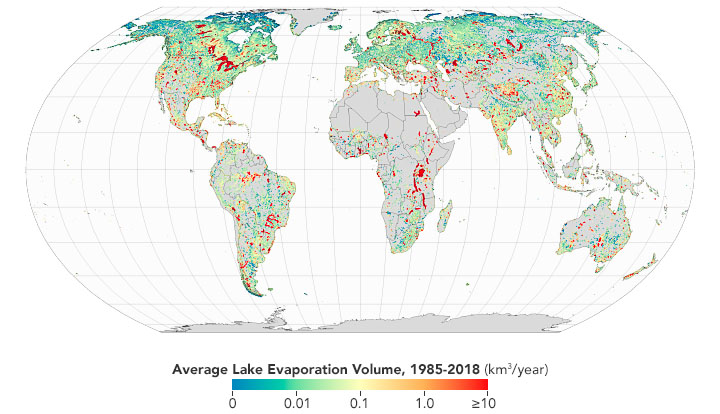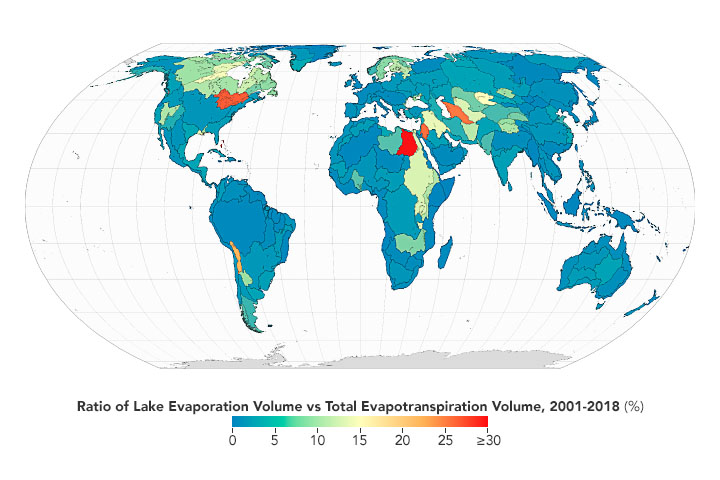


Earth is truly an ocean planet. Only 3 percent of Earth’s water is fresh, most of which is locked up in ice. Of the fraction of remaining fresh water, more than 87 percent resides in lakes. The amount of water lost from lakes by evaporation is a critical component of Earth’s water and energy budgets. (About 75 percent of the energy, or heat, in the global atmosphere is transferred through the evaporation of water from the Earth’s surface.)
Now, researchers have found that the amount of water evaporating from lakes is significantly more than previously thought, and that reservoirs may play an outsized role in the process, according to a new NASA-funded study published in Nature Communications.
The team, led by hydrologist Huilin Gao of Texas A&M University, used Landsat data to measure the surface areas of 1.42 million natural and artificial lakes (reservoirs). Previous studies on global lake evaporation have used basin-scale measures or gridded cells rather than individual lake areas.
The researchers then estimated the evaporation rate based on meteorology data and other factors, including how much heat is stored in the lake. Heat storage is an important driver of evaporation that hadn’t been accounted for in previous studies. The researchers next used the area and evaporation rate to calculate the volume of evaporative loss. They found that annually 1,500 (+/-150) cubic kilometers of water are lost worldwide—the equivalent of three Lake Eries.
“This suggests that lake evaporation plays a larger role in the hydrological cycle than previously thought,” said first author Gang Zhao, a global ecologist at the Carnegie Institution for Science, in a statement.
The map at top shows the spatial distribution of evaporative loss from lakes worldwide. Note the higher levels of loss in the north, where most lakes are located. “Even though the evaporation rate in these regions is small, the total evaporative water loss is substantial,” Gao said.
The researchers said the results underline the importance of using evaporation volume, rather than evaporation rate, to assess how climate change affects lakes. “Knowing that volume of evaporative loss is larger than previously estimated can also help us to better understand the role of lake evaporation in the hydrological cycle,” said Zhao.
Each year, roughly 450,000 cubic kilometers of water evaporate from the world’s oceans. An additional 71,000 cubic kilometers evaporate from the land, largely from soil and plants, but lakes play a role too. According to the new research, while lakes only account for 1.57 percent of the global land area, they contribute 2.37 percent of the water evaporated over land each year.

The above map shows the ratio of evaporation from lakes compared to total evaporation from the land by region. The land portion of the total evaporation was adopted from NASA’s Moderate Resolution Imaging Spectroradiometer (MODIS) Global Terrestrial Evapotranspiration product. Darker red and orange indicate that lake evaporation is a significant source of evaporation in those areas. This occurs in arid regions or areas with large lakes, such as the Great Lakes Basin.
Additionally, the team found that the rate of water loss accelerated by 3.12 cubic kilometers per year between 1985 and 2018. The increasing volume loss was driven by three factors, all influenced by climate warming: an increase in the evaporation rate, a decrease in ice cover, and an increase in lake surface area. The latter includes the construction of new reservoirs, which have increased the amount of open water by more than 500 square kilometers per year over the 34-year study period.
“Both climate change and the construction of new reservoirs have contributed to increased lake surface area,” Gao said. “For instance, the lake area in the Tibetan Plateau has been increasing due to glacier melt and increasing precipitation.”
The researchers also highlighted the data on reservoirs. While reservoirs account for only 5 percent of the volume, and 10 percent of the surface area, of all lakes, they contribute 16 percent of the evaporative loss. Additionally, while evaporation is increasing from lakes overall at a rate of 2.1 percent per decade, the rate of evaporation from reservoirs is increasing at a rate of 5.4 percent per decade.
“From a global perspective,” Zhao said, “the total reservoir evaporation can be larger than the combined use of domestic and industrial water,” not including agriculture, the largest user of water. “This suggests that reservoir evaporation is an indispensable factor in water management, especially in times of drought and global warming.”
The global lake evaporation volume (GLEV) dataset is the first long-term, monthly time series with data on such a large number of individual lakes. It is publicly available as an Earth Engine App.
NASA Earth Observatory image by Joshua Stevens, using data courtesy of Zhao, G., et al. (2022). Story by Sara E. Pratt.